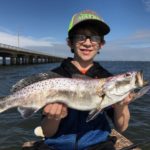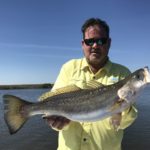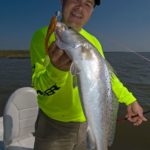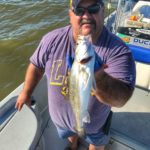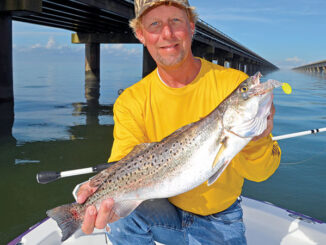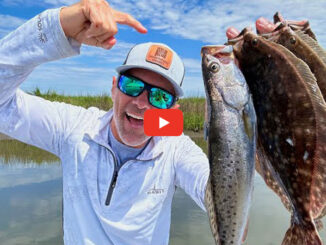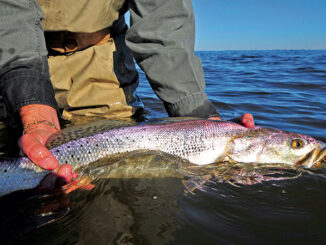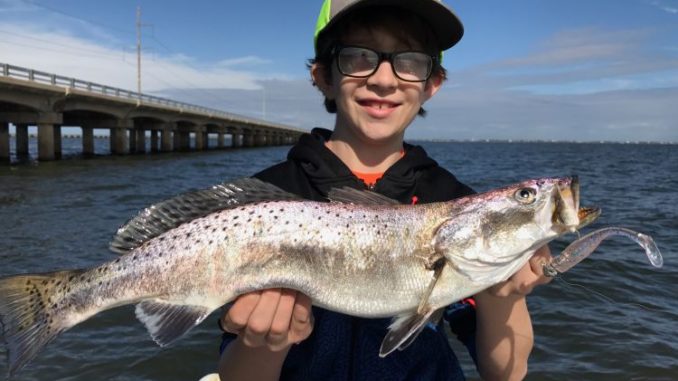
Even if you’re a dedicated weekend warrior, there’s always more to learn about catching specks. So be sure you aren’t making these mistakes that can impact the number of fish you put on ice.
We all live for the days when you leave the launch and birds are diving everywhere — and trout seem to fly over the gunnel right into the ice chest.
But, unfortunately, those trips seem to be the exception instead of the rule. The fact is that most anglers go home without rounding out their limits.
Sure, they might have pretty decent days of fishing, but limits for everyone on the boat? Those are as rare as a Baptist in a bar — it happens, but not every day.
So what’s the problem? Well, it’s likely that we anglers have developed bad habits, and the guides we talked to shared three mistakes that can be the difference between going home with enough fish for a fish fry, or barely sliming the deck.
Here are their thoughts:
Quiet is always best
Capt. Erik Rue spends his days on water in which 8 feet is deep — and most of his targets swim in less than 5 feet.
The Calcasieu Charter Service owner said spooking shallow-water trout is a real possibility, so he puts a premium on being as quiet as possible.
“The No. 1 mistake I see a lot of anglers make is they come in on a spot they want to fish, and put the trolling motor down and troll into where they want to be, instead of letting the wind push them into position,” Rue said.
When working shallow reefs, coves and bays, even the sound of the trolling motor can give trout the heads-up to your presence — and send them scurrying for other locales.
“You don’t want to be slamming lids and hitting the trolling motor in shallow water,” Rue said. “I still think being quiet is a big deal.”
Even the amount of line spooled onto your reel has a bearing on how quiet you can be, he said. This is especially important when hunting lunker trout.
“I think the average angler has too little line on his reel,” Rue said. “If the reel is three-quarters spooled, on their best cast they are averaging 10, 12, 15 yards closer to the boat than I am.
“That real estate is all the difference in the world. If you want to catch big trout, you’ve got to be able to cast a long way.”
He attributes silent approaches to the success of wade fishing, which is in vogue on Calcasieu Lake these days, but he said being able to cast farther negates the necessity of getting in the water.
“There’s a reason wade fishermen catch big trout: They can get a lot closer to the fish (without spooking them),” Rue said. “But if … they could cast a long way they wouldn’t need to get out of the boat.”
So the next time you’re fishing Big Lake — or any shallow-water system, for that matter — fully spool your reel, stop slamming the lids of your compartments and let nature put you in the proper position to fish your favorite spots.
“You’ve got to be quiet and cast a long way,” Rue said.
Watch that line
If you’ve fished Lake Pontchartrain because you heard all the hype, only to give up after a half day without a single bite, it’s likely you are making classic mistakes.
“You have to let the bait get all the way to the bottom,” Matrix Shad’s Chas Champagne said. “And you’ve got to watch your line.”
OK, so these are technically two mistakes, but they are related. And, while Champagne was speaking about Lake Pontchartrain, the concepts are equally important anywhere you fish deep trout (think nearshore platforms).
The key is to use a ⅜- or ½-ounce jig to get the bait all the way to the bottom — and do it often enough to know how long it takes to go all the way through the water column.
That allows you to pick up on the clues signaling the most subtle of bites.
“If it’s taking 3 seconds to get to the bottom and the lure looks like it reaches it in 2, it’s probably a fish that is either swimming to you or is sitting there with the lure in its mouth,” Champagne said. “You won’t feel it, but that could be a trout.”
So watch your line closely for any anomaly.
“You might see the line move to the side a little, or it just goes slack when it should be falling,” Champagne explained.
Being able to actually see these visual clues means line choice is critically important — and braids that are so popular nowadays really aren’t the best options.
“Most PowerPro is that forest green — and you’re not going to be able to see that line,” Champagne said. “So if you go with braid, use white or yellow. You can use a fluorocarbon leader if you feel like the fish are going to see the braid.”
However, he and most of the consistent Pontchartrain anglers go old school, preferring a line that is easier to see than hair-thin braid.
“We all use monofilament that we can see,” Champagne said.
His favorite for years was Stren clear/blue, and now he sells Matrix Line made to his specs.
“We just carry 14- and 17-pound test, which is perfect for the lake,” Champagne said. “It’s all about being able to see the line.”
Don’t sit too long
We’re all creatures of habit who, by nature, dislike change. So when we launch our boats, the odds are we head directly to the places we know — honey holes where success has been found during previous trips.
But living in the past can lead to frustration and empty ice chests.
That’s why Absolute Fishing Charter’s Capt. Marty LaCoste said it’s imperative to be mobile.
“Staying in one place too long is the biggest mistake a lot of anglers make,” LaCoste said. “They sit in one place for an hour and catch three or four fish.”
Many believe they just have to wait out the bite, but LaCoste said the better — and faster — way to build limits is to leave your comfort zone and find fish in the feeding mood.
“Move, move, move until you find fish,” LaCoste said. “You don’t want to wait an hour to catch five or six fish.”
Some anglers simply get lost in the seemingly innumerable options available in the marsh, but LaCoste said finding new hotspots is a just matter of finding the right conditions.
“Look for moving water. Look for current lines. Look for bait,” the guide said. “Look for all those things to find fish.”
But if you pull up to a nice current line sweeping around a point and don’t get a bite in 15 or 20 minutes, it’s probably time to find another spot.
“If you move to enough spots, you’ll find fish,” LaCoste said. “You could be done by 9:30 in the morning instead of having to fish all day.”
